Dunwoody, Georgia
| City of Dunwoody | ||
|---|---|---|
| City | ||
|
The Dunwoody Farmhouse, historic center of the community | ||
| ||
 Location in DeKalb County and the state of Georgia | ||
| Coordinates: 33°56′34″N 84°19′4″W / 33.94278°N 84.31778°WCoordinates: 33°56′34″N 84°19′4″W / 33.94278°N 84.31778°W | ||
| Country | United States | |
| State | Georgia | |
| County | DeKalb | |
| Government | ||
| • Type | Council-Manager | |
| • Mayor | Denis Shortal | |
| • City Manager | Eric Linton | |
| Area | ||
| • Total | 13.2 sq mi (34.1 km2) | |
| • Land | 12.9 sq mi (33.5 km2) | |
| • Water | 0.2 sq mi (0.6 km2) | |
| Elevation | 1,129 ft (344 m) | |
| Population (2012) | ||
| • Total | 47,224 | |
| • Density | 3,648/sq mi (1,408.5/km2) | |
| Time zone | Eastern (EST) (UTC-5) | |
| • Summer (DST) | EDT (UTC-4) | |
| ZIP codes | 30338, 30346, 30360 | |
| Area code(s) | 770, 678, 470 | |
| FIPS code | 13-24768 | |
| GNIS feature ID | 0325929[1] | |
| Website |
dunwoodyga | |
Dunwoody is a city located in DeKalb County, Georgia, United States. It is a northern suburb of Atlanta. Dunwoody became incorporated as a city on December 1, 2008.[2] As of 2015, the city has a population of 48,733, up from 46,267 in the 2010 Census.[3]
History
The Dunwoody area was established in the early 1830s and is named for Major Charles Dunwody (1828–1905), an extra "o" added with the incorrect spelling of the name on a banking note.[4][5] Charles Dunwody originally returned to Roswell after fighting in the Civil War, in which he fought for the secession of the Confederate states.[6]
One of Dunwoody's most historic buildings dates from 1829. The Ebenezer Primitive Baptist Church, at the corner of Roberts Drive and Spalding Drive, is still active to this date and is also the home to one of the city's oldest cemeteries, where many of the founding fathers of Dunwoody are buried. The first public school, Dunwoody Elementary, first stood near the city center at the intersection of Chamblee-Dunwoody Road and Mount Vernon Road. It was in continuous operation from 1911 to 1986. A fire destroyed the school's cafeteria in 1966, which was on the corner of Womack Road and Chamblee-Dunwoody Road. On that site today, the Dunwoody branch of the Dekalb County Public Library now operates along with the North Dekalb Cultural Arts Center. In 1881, the Roswell Railroad opened and ran along what is now Chamblee-Dunwoody Road north to the Chatahoochee River. It operated for 40 years, and in 1905, President Theodore Roosevelt made a campaign whistle stop in Dunwoody along the way to Roswell, Georgia.[7]
On account of the railroad, Dunwoody developed into a small crossroads community. The community continued to grow and prosper even after the railroad shut down in 1921.[8] Dunwoody remained rural until suburban residential development was initiated in the 1960s.[9] In 1971, the Spruill family sold a large portion of their property for the construction of Perimeter Mall, with the completion of Dunwoody Village occurring the same year.[9]
In early 2006, a study was conducted by the Carl Vinson Institute of Government of the University of Georgia, to determine how feasible it would be to incorporate Dunwoody as a city. Critics claimed that incorporation of Dunwoody, as in the incorporation of Sandy Springs in 2005, would take away a great deal of tax revenue from the rest of the county, leading to shortages of services, tax increases, or both for everyone else in the county, as has happened in Fulton. Citizens for Dunwoody, Inc. was the non-profit advocacy group begun by Senator Dan Weber to promote the effort.[10]
The bill for incorporation was withdrawn from the Georgia General Assembly for further study in 2006 and passed only the lower house in 2007.[11] In 2008, the bill of incorporation was re-introduced by Senator Weber, and due to increased pressure, it passed in the senate as well as the house. Georgia Governor Sonny Perdue signed the bill allowing the residents to vote for a city of Dunwoody on March 25. The referendum for cityhood, which took place on July 15, was approved by an overwhelming majority of voters. The Dunwoody City Charter was later ratified by the Georgia General Assembly, and on December 1, 2008, after a three-year movement, Dunwoody officially became a city.
Geography
Dunwoody's geographic center is at 33°56′34″N 84°19′4″W / 33.94278°N 84.31778°W (33.942751, -84.317694).[12] According to the United States Census Bureau, Dunwoody has a total area of 13.2 square miles (34.1 km2), of which 12.9 square miles (33.5 km2) is land and 0.23 square miles (0.6 km2), or 1.72%, is water.[3] Dunwoody lies at the northern tip of DeKalb County, bounded by the Fulton County line on the north and west, Interstate 285 on the south, Peachtree Industrial Boulevard on the southeast, and the Gwinnett County line on the northeast.[13]
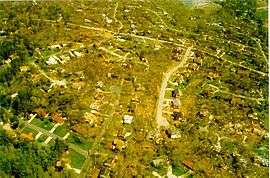
Late on April 8, 1998, a major tornado tore through parts of Dunwoody, running east-northeast from Perimeter Center and into Gwinnett County. Thousands of homes were damaged, hundreds seriously, and several dozen were condemned. In addition, tens of thousands of native forest trees were downed. The vast majority of the tornado's damage occurred here, leading it to be called the "Dunwoody tornado", the most vivid in local memory until the 2008 Atlanta tornado.
Districts & neighborhoods
Dunwoody Village is the historic heart of the community, and the location of the iconic Dunwoody Farmhouse. The distinctive Colonial Williamsburg architectural style of the district originated with the construction of Dunwoody Village Shopping Center in the 1970s, for which the district gets its name. Since then, all other construction in the area followed suit, giving Dunwoody a unique architectural identity and sense of place.[14]
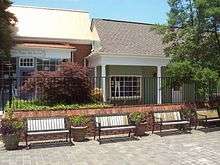
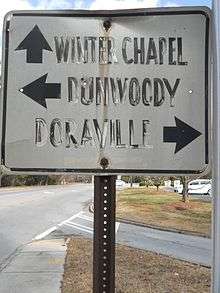
Perimeter Center is the major edge city and neighborhood that has formed around Perimeter Mall. The mall was developed in 1971, spurring major office, residential, and commercial developments in the decades since. It is one of Metro Atlanta's largest job centers, employing hundreds of thousands of people each day. Perimeter Mall and approximately 40 percent of the Perimeter Community Improvement District,[15] is a self-taxing district of shopping and office buildings (including several high-rises), are both located in Dunwoody. The western part of Perimeter Center edge city spans the Fulton county line into Sandy Springs. The tallest building in Dunwoody is the 34-story Ravinia 3, at 444 feet (135 m). Perimeter Center is located at the intersection of two major highways, GA 400 and I-285. The Dunwoody Transit Station provides public transit to the district.[16]
Georgetown' was developed in the early 1960s. It is located near I-285 and borders with the city limits of Chamblee. Overdevelopment in Georgetown was one of the main reasons for the initiation of Dunwoody's incorporation movement, with many new apartments being approved for the area, even in some single-family residential areas. Georgetown, one of the most walkable areas of the city, contains both single-family residential subdivisions and its own retail district.[17] This includes Kroger, who also owns and manages the property.
The Williamsburg commercial district is located on the eastern edge of Dunwoody, adjacent to the Dunwoody Panhandle of Sandy Springs.[18][19] Shopping areas include Orchard Park Shopping Center, Mt. Vernon Shopping Center and the Williamsburg at Dunwoody Shopping Center. The centralized dining and shopping covers the intersection of Mt. Vernon, Dunwoody Club Drive, and Jett Ferry Road.
Winters Chapel is located at Dunwoody's border with Peachtree Corners. The district shares a name with its main road, which travels through Fulton, Gwinnett and DeKalb County and was an important 19th century route connecting Decatur and Roswell via Holcomb Bridge Road. The district is named after Winters Chapel (now Winters Chapel Methodist Church), which has resided at its present location since the 1870s.[20] The church itself is named after an instrumental founder, Jeremiah Winters.[21] The area is a prime location for light commercial and retail redevelopment opportunities due to good demographics and traffic counts. Two parks, connected by sidewalks, dominate Winters Chapel. The 3/4 mile long, meticulously groomed, linear park running along DeKalb County's Twin Lakes water reservoir on Peeler Road is popular with walkers and joggers. Windwood Hollow Park, at Lakeside Drive and Peeler Road, offers tennis, a children's play area, a picnic pavilion, and a short trail.[18]
Tilly Mill is named after the pioneer Tilly family, who owned a late 19th-century farm and mill on land bisected by Tilly Mill Road, which connects Dunwoody to Peachtree Industrial and Doraville.[22] Landmarks in the area include the Dunwoody campus of Georgia State Universities Perimeter College and Dunwoody's signature park, Brook Run. Brook Run, on North Peachtree Road near its intersection with Tilly Mill Road, boasts many wooded walking trails, a children's play area, a dog park, a Veterans Memorial, and a community garden. The 103-acre (0.42 km2) site will see major improvements as Dunwoody plans for its future.[18] Also in Tilly Mill is the Marcus Jewish Community Center, an Orthodox synagogue, and a significant portion of Dunwoody's Jewish population.
Cityscape

Demographics
| Historical population | |||
|---|---|---|---|
| Census | Pop. | %± | |
| 1980 | 17,768 | — | |
| 1990 | 26,302 | 48.0% | |
| 2000 | 32,808 | 24.7% | |
| 2010 | 46,267 | 41.0% | |
| Est. 2015 | 48,733 | [23] | 5.3% |
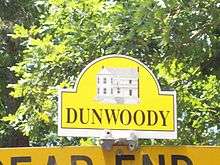
As of the census[25] of 2010, there were 46,267 people, 19,944 households, and 11,723 families residing in the city. The population density was 3,421 people per square mile (1,304/km²). There were 21,671 housing units at an average density of 1,582 per square mile (611/km²). The racial makeup of the city was 69.8% White, 12.8% African American, 0.3% Native American, 11.1% Asian, 0.1% Pacific Islander, 3.6% from other races, and 2.3% from two or more races. Hispanic or Latino of any race were 10.3% of the population.
There were 19,944 households out of which 29.9% had children under the age of 18 living with them, 47.8% were married couples living together, 8.1% had a female householder with no husband present, and 41.2% were non-families. 29.9% of all households were made up of individuals and 6.3% had someone living alone who was 65 years of age or older. The average household size was 2.31 and the average family size was 3.0.
The population was spread out with 23.4% under the age of 18, 2.0% from 18 to 21, 62.3% from 22 to 64, and 12.3% who were 65 years of age or older. The median age was 35.7 years. For every 100 females there were 92.8 males. For every 100 females age 18 and over, there were 89.7 males.
The median income for a household in the city was $76,809, and the median income for a family was $106,777. Males had a median income of $78,778 versus $51,081 for females. The per capita income for the city was $45,484. About 6.2% of families and 7.9% of the population were below the poverty line, including 10.2% of those under age 18 and 3.1% of those age 65 or over.
Government
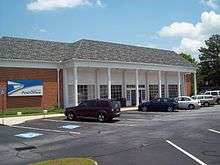
The city has a council-manager form of municipal government. Its first mayor was Ken Wright. The current mayor is Denis "Denny" Shortal, elected in November 2015. The city manager is Eric Linton.
Dunwoody's city hall is located in a Perimeter Center office building at 41 Perimeter Center East. It was originally at a temporary location in the city of Sandy Springs for most of its first year, until it signed a long-term lease for its current space.
Dunwoody operates its own police force of 54 officers, as well as departments over zoning and land use. The city receives services from DeKalb County including: DeKalb County Schools, Dekalb County Fire & Rescue, sanitation, water, and sewage.
Economy
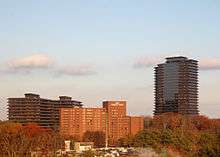
The Atlanta Journal-Constitution has its headquarters in the Perimeter Center and in Dunwoody.[26][27][28] In 2010 the newspaper relocated its headquarters from Downtown Atlanta to leased offices in the Perimeter Center for financial reasons.[28]
InterContinental Hotels Group operates its American corporate offices in Dunwoody.[27][29] Porsche Cars North America, Inc. (PCNA) also has its American corporate offices in Dunwoody.
Top employers
According to the City's 2011 Comprehensive Annual Financial Report, the top employers in the city are:[30]
| # | Employer | # of Employees |
|---|---|---|
| 1 | InterContinental Hotels Group | 906 |
| 2 | Walden Security | 881 |
| 3 | The Atlanta Journal-Constitution | 607 |
| 4 | Peachford Hospital | 498 |
| 5 | AutoTrader.com | 441 |
| 6 | ER Solutions | 378 |
| 7 | Macy's | 371 |
| 8 | Walmart | 313 |
| 9 | iHealth Technologies | 310 |
| 10 | Computer Generated Solutions | 292 |
Education
Primary and secondary schools
The DeKalb County School System (DCSS) operates local public schools.
Elementary schools operated by DCSS include:
- Austin Elementary School
- Chesnut Charter Elementary School
- Kingsley Elementary School
- Vanderlyn Elementary School
- Dunwoody Elementary School
High and Middle Schools Operated by DCSS in Dunwoody include:
Colleges and universities
- Georgia State University, Dunwoody Campus (formerly Georgia Perimeter College)
- American InterContinental University (AIU Dunwoody) Just across the county line in neighboring Sandy Springs.
- Troy University, Atlanta site
Public libraries
DeKalb County Public Library operates the Dunwoody Branch.[31]
Transportation
Highways
- Interstate 285, also called The Perimeter, runs along the city's southern border.
- A limited access portion of Georgia State Route 141 runs along the southeastern border.
- Georgia State Route 400, while in neighboring Sandy Springs, is very close to the city's western border.
Mass transit
The Metropolitan Atlanta Rapid Transit Authority (MARTA) provides subway and bus service to Dunwoody and the surrounding area.
MARTA subway stations in Dunwoody are concentrated in the western part of the city. The Dunwoody station is the only station within the city limits, although Medical Center, Sandy Springs station, and North Springs station are very close to the western border. All stations in the area are served exclusively by the Red Line.[32]
While some routes serve the outskirts of the city, there are three main bus routes, one of which leaves from the Dunwoody Station(Route 150).[33]
- Route 103 - Peeler Rd./N. Shallowford Rd.
- Route 132 - Tilly Mill Road
- Route 150 - Perimeter Center/Dunwoody Village
Notable people
- Erin Andrews, ESPN reporter, lived here while working for Fox Sports South
- Bret Baier, Host of Special Report with Bret Baier
- Harris Barton, former professional football player, San Francisco 49ers
- Black Lips, "flower punk" band
- Alex Caskey, professional soccer player, Seattle Sounders FC
- Monsignor R. Donald Kiernan, longest serving pastor of All Saints Catholic Church
- Doug Kincaid, artist and puppeteer, grew up here
- William Kincaid, artist and designer, grew up here
- Robin Meade, anchor CNN Headline News
- Kip Pardue, actor
- Ryan Seacrest, host of American Idol
- Corey White, Cornerback for the New Orleans Saints
- Jeff Williams, American poker player
- Cindy Wilson, "B 52's" band
References
- ↑ "US Board on Geographic Names". United States Geological Survey. 2007-10-25. Retrieved 2008-01-31.
- ↑ Hunt, April (2008-11-30), Atlanta Metro News. Retrieved on 2010-10-19.
- 1 2 "Geographic Identifiers: 2010 Demographic Profile Data (G001): Dunwoody city, Georgia". U.S. Census Bureau, American Factfinder. Retrieved October 21, 2015.
- ↑ A history and genealogy of the ... - Google Books. Books.google.com (2007-04-20). Retrieved on 2010-10-19.
- ↑ The life of Theodore Roosevelt ... - Google Books. Books.google.com (2007-07-18). Retrieved on 2010-10-19.
- ↑ Books.google.com (2010). Retrieved on 2010-18-11.
- ↑ Dunwoody Homeowners Association … About … History. Dunwoodyga.org. Retrieved on 2010-10-19.
- ↑ About Dunwoody. Dunwoodyga.gov (2008-12-01). Retrieved on 2013-09-06.
- 1 2 Dunwoody resident tracks Village Mill history - Dunwoody Crier: Past Tense. Thecrier.net (2007-07-17). Retrieved on 2013-09-06.
- ↑ Under Construction. Citizensfordunwoody.org. Retrieved on 2010-10-19.
- ↑ sb82.html. Legis.ga.gov. Retrieved on 2010-10-19.
- ↑ "US Gazetteer files: 2010, 2000, and 1990". United States Census Bureau. 2011-02-12. Retrieved 2011-04-23.
- ↑ About Dunwoody. Dunwoodyga.gov (2008-12-01). Retrieved on 2010-10-19.
- ↑ The Dunwoody Crier - Front. Thecrier.net (2010-09-28). Retrieved on 2010-10-19.
- ↑ Home Page. Perimeter Community Improvement Districts. Retrieved October 27, 2008.
- ↑ Perimeter Community Improvement Districts. Perimetercid.org. Retrieved on 2010-10-19.
- ↑ The Dunwoody Crier - News. Thecrier.net (2010-09-23). Retrieved on 2010-10-19.
- 1 2 3 The Dunwoody Crier - Front. Thecrier.net (2010-01-05). Retrieved on 2010-10-19.
- ↑ http://thecrier.net/articles/2010/11/02/front/teasers/01tease.txt
- ↑ Baptis? Methodist? The Winter's the same - Dunwoody Crier: In My Opinion. Thecrier.net (2005-02-08). Retrieved on 2013-09-06.
- ↑ Street name answers - Dunwoody Crier: Past Tense. Thecrier.net (2010-02-02). Retrieved on 2013-09-06.
- ↑ The Dunwoody Crier - Past TenseColumnists. Thecrier.net (2010-04-06). Retrieved on 2010-10-19.
- ↑ "Annual Estimates of the Resident Population for Incorporated Places: April 1, 2010 to July 1, 2015". Retrieved July 2, 2016.
- ↑ "Census of Population and Housing". Census.gov. Retrieved June 4, 2015.
- ↑ "American FactFinder". United States Census Bureau. Retrieved 2008-01-31.
- ↑ "Customer Care". The Atlanta Journal-Constitution. Retrieved September 29, 2010.
The Atlanta Journal-Constitution 223 Perimeter Center Pkwy. Atlanta, GA 30346
- 1 2 "Map of Dunwoody". City of Dunwoody. Retrieved September 29, 2010.
- 1 2 Collier, Joe Guy (August 17, 2009). "AJC moving from downtown to Perimeter Mall area". Atlanta Journal-Constitution. Retrieved October 23, 2009.
- ↑ "Contact us." InterContinental Hotels Group. Retrieved on March 5, 2010.
- ↑ City of Dunwoody CAFR
- ↑ "Library Locations & Hours." DeKalb County Public Library. Retrieved on February 24, 2010.
- ↑ "Red Line Map: Red Line". itsmarta. Metropolitan Atlanta Rapid Transit Authority. Retrieved 22 July 2015.
- ↑ "Bus Information by Route Number". itsmarta. Metropolitan Atlanta Rapid Transit Authority. Retrieved 22 July 2015.
External links
| Wikivoyage has a travel guide for Dunwoody. |
- City of Dunwoody official website
- Dunwoody Homeowners Association
- The Crier, local newspaper
- Dunwoody Chamber of Commerce
- Convention and Visitors Bureau of Dunwoody
- Rotary Club of Dunwoody

